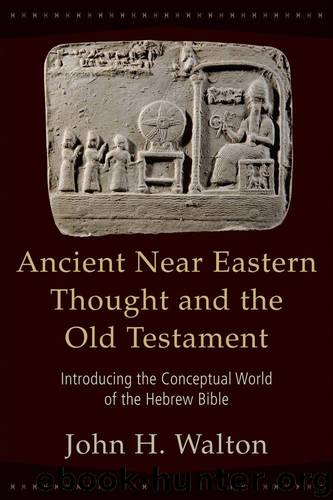Ancient Near Eastern Thought and the Old Testament: Introducing the Conceptual World of the Hebrew Bible by John Walton

Author:John Walton
Language: eng
Format: mobi, epub
Tags: Religion, Old Testament, Biblical Criticism & Interpretation, Biblical Studies
ISBN: 9781585582914
Publisher: Baker Academic
Published: 2006-10-31T22:00:00+00:00
Creation History
Divine role Both focus on divine cause and effect
Perspective Both driven by purpose (teleological)
Foundation Order Pattern
Focus Function Outcome/Legacy
De-emphasized Structures/physical laws Eyewitnessed events
* * *
* * *
In the ancient pursuit of coherence, hindsight was not only important, it was essential. Likewise, a transcendent view of history was essential.[28] A sense of what “really happened” was gained in light of the outcome, not in light of what any given eyewitness thinks he might have seen, since eyewitnesses were also limited by their perspective and compromised by their opinions. What one saw could barely begin to offer insight into what really happened. Indeed, it was particularly what could not be seen that was often critical. It was only as events blended together into a continuum that significance could be identified. Individual events find their value in the continuity and relationship they share with other events. Time and hindsight therefore allow for increasing coherence, the hallmark of narrative historiography.
The particular cognitive environment of the ancient world led to a focus on certain anticipated outcomes. The outcomes that were most important were of an ideological nature, and therefore the historiographers typically offered theological and/or political interpretation of events (with the understanding that what was political was still ultimately theological). Their interest in the past was concerned primarily with actions of the deity and the legitimation of the king. These had priority over any mere recitation or reconstruction of the events.[29] Consider E. A. Speiser’s remark: “The Bible is not so much a chronicle of events worth recording, or thought to be worth recording, as an interpretation of significant happenings.”[30] The events had to be seen in light of the outcome, and the outcome had to be understood in light of the royal and the divine. The events were shaped to give fullest articulation of outcome and the patterns that can be identified in a series of outcomes. The events were reported not as an eyewitness would have seen them, but as part of the interpretation of the outcome. They knew what they knew about the past because it had been interpreted for them. This interpretive testimony is what they gathered and preserved. Since all testimony has come through an interpreter to take the form of a record (oral, written, or artifactual), we must now delve into the poetics of historiography.
Download
Ancient Near Eastern Thought and the Old Testament: Introducing the Conceptual World of the Hebrew Bible by John Walton.epub
This site does not store any files on its server. We only index and link to content provided by other sites. Please contact the content providers to delete copyright contents if any and email us, we'll remove relevant links or contents immediately.
| Exegesis & Hermeneutics | New Testament |
| Old Testament |
The Five People You Meet in Heaven by Mitch Albom(2855)
Name Book, The: Over 10,000 Names--Their Meanings, Origins, and Spiritual Significance by Astoria Dorothy(2501)
Real Sex by Lauren F. Winner(2492)
The Holy Spirit by Billy Graham(2436)
The Secret Power of Speaking God's Word by Joyce Meyer(2264)
0041152001443424520 .pdf by Unknown(2233)
How The Mind Works by Steven Pinker(2231)
ESV Study Bible by Crossway(2163)
Ancient Worlds by Michael Scott(2115)
The Meaning of the Library by unknow(2079)
The Gnostic Gospels by Pagels Elaine(2043)
Churchill by Paul Johnson(2020)
MOSES THE EGYPTIAN by Jan Assmann(1982)
The ESV Study Bible by Crossway Bibles(1979)
Jesus by Paul Johnson(1897)
Ancient Near Eastern Thought and the Old Testament by John H. Walton(1858)
The Nativity by Geza Vermes(1856)
The Complete Dead Sea Scrolls in English (7th Edition) (Penguin Classics) by Geza Vermes(1853)
City of Stairs by Robert Jackson Bennett(1844)
